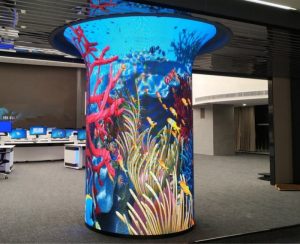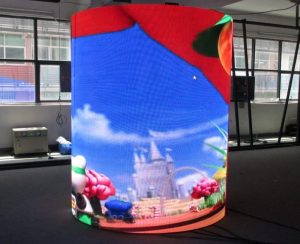1. The point spacing should be as small as possible; the point spacing is the spacing between the center points of adjacent pixels on the LED display. The smaller the interval between points, the more pixels per unit area, the higher the resolution, and the closer the photo interval, of course, the more expensive it is. In order to achieve the excellent effect, we should seriously study the relationship between the resolution of signal source and the point interval, strive to achieve the same resolution, arrive at the point-to-point display, and then complete the best effect.
2. The filling factor should be high
The fill factor of LED display is also known as the ratio of the luminous area of each pixel to the physical surface area of the pixel. LED display screen is composed of discrete pixels, and there are obvious non luminous black areas between the pixels. When viewed at close intervals, the picture is incoherent and incomplete, and the brightness is uneven, resulting in graininess. Assuming that the light source is limited to a very small pixel surface area, resulting in the brightness of a single pixel being several times or even more than ten times of that of the whole screen, a more severe glare will be formed.
According to the TCO’99 standard, the fill factor of flat panel display should not be less than 50%. Many LED displays in the market have not reached this goal. The cut-off characteristic of low-pass filter of TV also directly affects the suitable photo interval of LED display screen with different fill factor. For the LED display screen with the same interval, the smaller the fill factor is, the more the attenuation is, so the photo interval needs to be increased. Assuming that the low-pass filter passband of the system is 4MHz and the attenuation characteristic of high frequency is 12dB / octave, the photo interval with 25% fill factor will be 1.15db more than that with 50% fill factor, and the photo interval needs to be increased by about 10%. With the improvement of fill factor, the viewing angle of the display screen is more extensive, and the color mixing effect is more ideal, which overcomes the eye-catching problem of pixels, and creates conditions for properly improving the brightness of the whole screen to achieve a very good effect.
3. Color temperature can be adjusted
Color temperature is the temperature determined by comparing the shape of emitter emission spectrum with the best fitting shape of blackbody emission spectrum. When the studio uses the LED display screen as the setting, its color temperature should be the same as that of the lights in the studio, so that the accurate color reproduction can be obtained in the photography. According to the needs of the program, the lights in the studio sometimes use 3200K low color temperature lamps, sometimes use 5600k high color temperature lamps, and the LED display screen rental needs to adjust to the corresponding color temperature, and then obtain the photo function.
4. Take photos at proper intervals
As mentioned in the previous discussion on spacing and fill factor, the appropriate photo interval is different for LED displays with different point spacing and fill factor. The space between the person to be photographed and the screen is 4-10 meters, which is suitable for the contrast. In this way, when taking pictures of the person, we can get a set picture with excellent contrast. Assuming that the character is too close to the screen, when taking a close shot, the set will show a sense of graininess, which is also a simple occurrence of mesh interference.
5. Ensure excellent application environment
The failure rate of the commodity is low only under the suitable operation conditions in the service life period. As an integrated electronic commodity, LED display rental is mainly composed of control panel with electronic devices, switching power supply, light-emitting devices, etc., and the longevity and stability of all these components are closely related to the operating temperature. Assuming that the practical operation temperature exceeds the application scope of commodity rules, not only its life will be shortened, but also the commodity itself will be severely damaged. In addition, the threat of dust can not be ignored. When working in the environment with large dust contrast, PCB absorbs dust, and the deposition of dust will affect the heat dissipation of electronic components, which will lead to the temperature rise of electronic components, resulting in the decrease of thermal stability and even the occurrence of electric leakage. In severe cases, it will cause burnout. Dust will also absorb moisture, and then corrosion of electronic circuits, the formation of some difficult to check the short circuit. Pay attention to the cleaning of the studio. There will be a lot of dust in the transformation of the studio, so it is necessary to protect the LED display screen in advance.
The use of LED screen rental greatly enriches the display mode of the program set. As a set, LED screen rental is suitable for large-scale variety shows with large scenes and large studios.
What should we pay attention to in the use of LED display screen?




